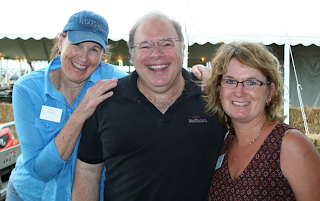Behind the Scenes at the Symphony
I want to introduce you to two of the hardest working people around, Emily Hunter (left), the executive director of Symphony in the Flint Hills and Linda Craighead the site manager of the event. While everyone was having a great time, these two were in constant motion behind the scenes to insure everything went well.
From 9 o’clock Saturday morning through 10:45pm, the three of us worked together, along with the meteorologists at WeatherData’s forecast center, to insure the 7,200 people (a complete sell-out) were safe in the remote location. Lightning, hail, high winds, tornadoes and flash floods were all possible the day of the event because of a stationary front right over the site and extremely unstable air to the south. I spent virtually the entire day glued to the computer because of volatility of the weather situation.
At 10:30am, when we had the official weather meeting, things looked grim at first glance: There were thunderstorms 9 miles to the southeast and 12 miles northeast of the site and a drizzle was falling. However, given the newly developed tools created by the NOAA Storm Prediction Center, I was able to confidently forecast that the event could be safely held, at least until 9pm, even though things weren’t ideal at decision time. I said the skies would start to clear around 1pm.
Banners depicting the bluestem tallgrass accented with musical instruments.
The first forecast turned out to be excellent. The first patches of blue sky showed themselves at 1:16pm.
The second forecast held as well. We were able to get through the entire concert in good shape. We were hopeful that we would get through the after-concert activities (music, a dance, etc.) but Mother Nature intervened.
Towering cumulus clouds southwest of the site shortly before the concert began indicated the unstable atmosphere that was ripe for thunderstorm development.
A small area of thunderstorms with both in-cloud and cloud-to-ground lightning developed south southwest of the site and started moving directly toward it. While conditions had been unfavorable for thunderstorm development prior to sunset, the tools I had indicated that those thunderstorms could be sustained. Given that it would take people, once informed, 45 minutes to walk to their cars (there was no safe shelter at the site, which is selected for its remoteness deep in the Flint Hills) I advised Emily to spread the word that lightning was possible and that people should move to the safety of their cars. The forecast caused the post-concert parties to be shortened.
The finale of the concert.
Well, Mother Nature surprised me and the storms dissipated before reaching the site.
As I write in Warnings, the next challenge for weather science is to cut down on the false alarms. The tools I had indicated conditions were right for thunderstorm intensification (which did indeed occur about an hour later.) Meteorology is doing a very good job getting alerts out before dangerous storms, but our techniques to tell when storms are going to weaken are not as mature.
From the people I have spoken with, no one seemed too disappointed. I believe people realize that it is better to err on the side of safety – getting to their cars dry, at a leisurely pace, and safely.









Comments
Post a Comment